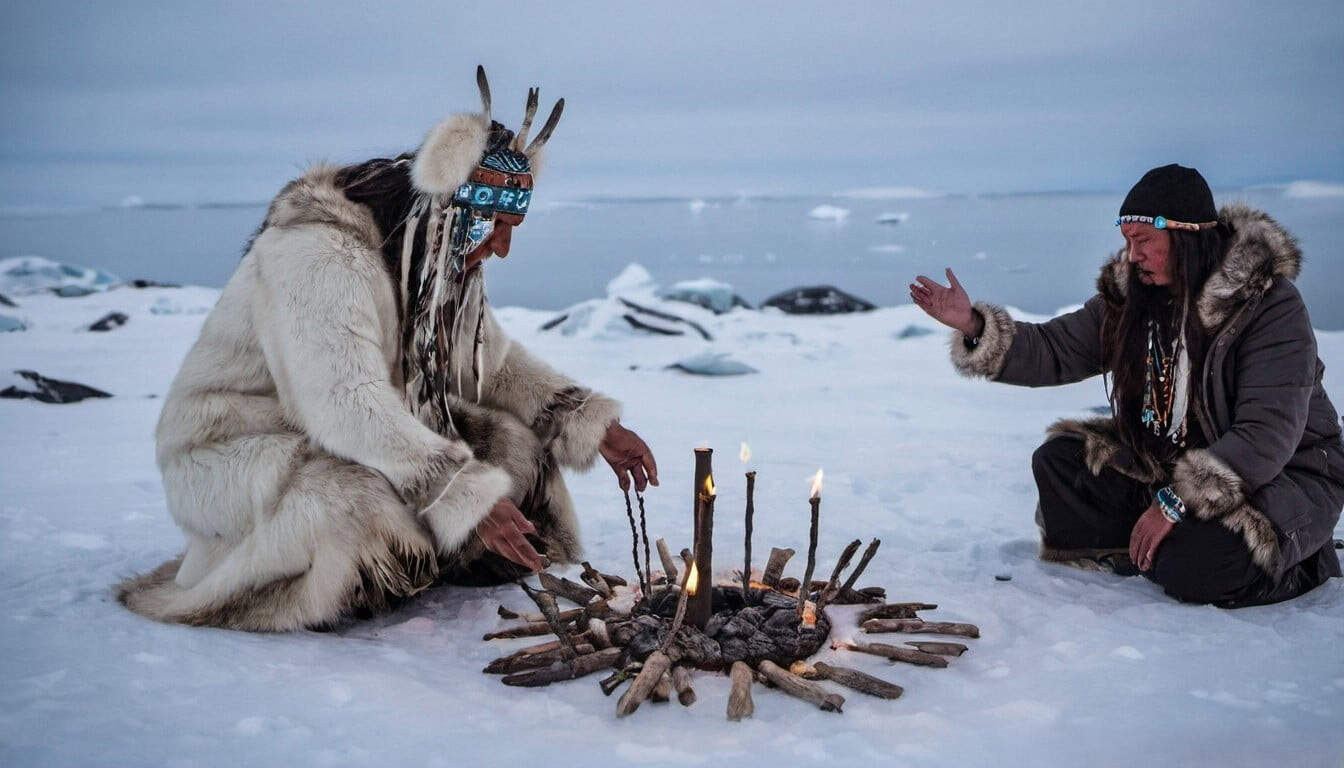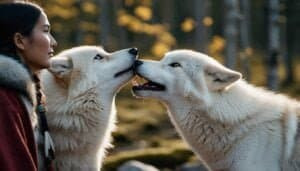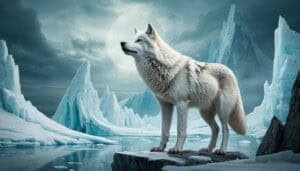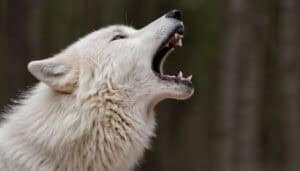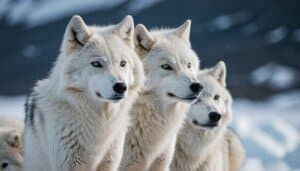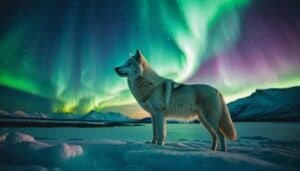Introduction
Arctic wolves hold a unique place in the shamanic traditions of Arctic cultures. This article explores the historical significance and symbolic meanings of Arctic wolves in shamanic rituals
We will delve into how these majestic animals are incorporated into ceremonies, the methods shamans use to communicate with them, and the spiritual beliefs that surround them
Additionally, we will examine the tools and materials used in these rituals and how they have evolved over time. By the end of this article, readers will gain a comprehensive understanding of the integral role Arctic wolves play in shamanic traditions
Historical Significance of Arctic Wolves in Shamanic Rituals
Arctic wolves, known scientifically as Canis lupus arctos, have long been revered in the shamanic traditions of indigenous Arctic cultures. These majestic animals, adapted to the harsh conditions of the Arctic tundra, are seen not only as physical beings but also as spiritual entities that hold significant power and wisdom
The historical significance of Arctic wolves in shamanic rituals can be traced back thousands of years, with various tribes considering them totem animals, guides, and protectors
Origins of Wolf Symbolism in Arctic Cultures
The origins of wolf symbolism in Arctic shamanism are deeply rooted in the animistic beliefs of these cultures. Animism is the belief that all natural phenomena, including animals, plants, and even inanimate objects, possess a spirit
Arctic shamans, or angakkuit as they are known among the Inuit, have long believed that Arctic wolves embody the spirit of the wilderness and possess unique qualities such as strength, endurance, and keen intuition
Historical evidence suggests that Arctic wolves were often depicted in ancient petroglyphs and carvings, symbolizing their revered status. These representations highlight the early recognition of wolves as spiritual beings and their integral role in the shamanic worldview
The connection between humans and wolves is believed to have been forged through mutual respect and the recognition of wolves’ abilities to survive and thrive in the same harsh environments that humans inhabited
Evolution of Wolf-Related Rituals
Over time, the rituals involving Arctic wolves have evolved, adapting to changes in societal structures and environmental conditions. Initially, these rituals were likely simple acts of reverence and communication with the wolf spirits, seeking their guidance and protection. As shamanic practices became more complex, so did the rituals
One significant evolution in these rituals was the incorporation of wolf elements into healing ceremonies
Shamans began to channel the spirit of the wolf to invoke its healing powers, believing that the wolf’s keen senses and resilience could aid in diagnosing and curing ailments. This practice involved wearing wolf pelts, mimicking wolf howls, and entering trances to connect with the wolf spirit
In addition to healing rituals, hunting ceremonies also saw the inclusion of wolf elements. Shamans would call upon the wolf spirit to guide hunters, believing that the wolves’ natural hunting prowess could be transferred to humans. These rituals often included dances and chants that mimicked wolf behavior, fostering a deep connection between the hunters and the spirit world
Key Historical Accounts of Wolves in Shamanism
Numerous historical accounts and oral traditions document the presence of Arctic wolves in shamanic practices. One notable account comes from the early 20th century ethnographer Knud Rasmussen, who documented the beliefs and rituals of the Inuit people
According to Rasmussen, shamans would often perform rituals at wolf dens, seeking the blessing of the wolves before embarking on important journeys or hunts
Another significant historical account involves the Chukchi people of Siberia. The Chukchi, whose territory overlaps with that of the Arctic wolf, have long considered the wolf to be a sacred animal
In their rituals, the Chukchi shamans would wear wolf masks and costumes, believing that by embodying the wolf, they could access its spiritual powers. These rituals were often performed during times of crisis, such as illness or environmental upheaval, to invoke the strength and resilience of the wolf
The integration of Arctic wolves into shamanic rituals also extended to the use of wolf bones and other parts in ceremonial objects. These items were believed to carry the essence of the wolf spirit and were used in various rituals to ensure protection and success. For instance, wolf bones were often crafted into amulets and worn by hunters to invoke the wolf’s hunting abilities
The Role of Arctic Wolves in Shamanic Ceremonies
Arctic wolves play a multifaceted role in the shamanic ceremonies of indigenous Arctic cultures. These rituals, deeply embedded in the spiritual and cultural fabric of these communities, utilize the unique attributes of Arctic wolves to achieve various spiritual and practical objectives
The following sections will explore the different types of ceremonies involving wolves, the specific ritual practices and techniques employed, and notable case studies of wolf participation
Types of Ceremonies Involving Wolves
The inclusion of Arctic wolves in shamanic ceremonies spans a variety of ritual types, each serving distinct purposes within the community
Some of the primary types of ceremonies include healing rituals, hunting ceremonies, spiritual guidance rituals, and rites of passage:
Healing Rituals: Arctic wolves are believed to possess powerful healing energies
In these rituals, shamans channel the spirit of the wolf to diagnose and treat illnesses. The process often involves entering a trance state to communicate with the wolf spirit and asking for its intervention in healing the patient. The wolf’s perceived strength and vitality are thought to be transferred to the sick individual, aiding their recovery
Hunting Ceremonies: Before setting out on hunts, shamans perform ceremonies to invoke the guidance and protection of the wolf spirit
Wolves are revered for their hunting skills, and these rituals aim to imbue hunters with similar prowess. The shaman might use wolf fur, bones, or teeth as part of the ceremony, believing these items carry the essence of the wolf’s abilities
Spiritual Guidance Rituals: Shamans often seek the wisdom and guidance of the wolf spirit in making important decisions or navigating challenging situations. These ceremonies typically involve meditation, chants, and offerings to the wolf spirit, seeking its insight and support
Rites of Passage: Wolves are also central to rites of passage, marking significant transitions in an individual’s life, such as reaching adulthood or becoming a shaman. These ceremonies celebrate the qualities attributed to wolves, such as strength, independence, and resilience, which the community hopes to instill in the individual undergoing the rite
Ritual Practices and Techniques
The practices and techniques used in wolf-related shamanic rituals are diverse, often tailored to the specific objectives of the ceremony and the traditions of the community
Some common elements include the use of wolf-related paraphernalia, symbolic gestures, and altered states of consciousness:
Use of Wolf Paraphernalia: Shamans frequently incorporate items derived from wolves, such as pelts, bones, teeth, and claws, into their rituals
These objects are believed to carry the spiritual essence of the wolf and serve as conduits for its power. For example, wearing a wolf pelt during a healing ritual is thought to enhance the shaman’s ability to channel the wolf’s healing energy
Symbolic Gestures and Movements: Rituals often include symbolic gestures and movements that mimic the behavior of wolves
These actions are intended to create a connection between the shaman and the wolf spirit. For instance, shamans may howl like wolves, move in a manner reminiscent of a wolf’s gait, or engage in dances that symbolize hunting or other wolf activities
Altered States of Consciousness: Achieving an altered state of consciousness is a critical component of many shamanic rituals
Shamans may enter trance states through drumming, chanting, meditation, or the use of sacred plants. In these states, they believe they can communicate directly with the wolf spirit, receive its guidance, and harness its power for the ritual’s purposes
Case Studies of Wolf Participation
The Inuit Shaman’s Healing Journey
Among the Inuit, there are numerous documented instances of shamans embarking on spiritual journeys with the aid of wolf spirits
In one notable case, an Inuit shaman named Qalupalik was known for her ability to heal the sick by calling upon the spirit of the Arctic wolf. She would don a wolf pelt, enter a trance, and travel to the spirit world to seek the wolf’s aid
Her rituals often involved intricate dances and chants that were believed to attract the wolf spirit to her aid
Chukchi Wolf Hunting Rituals
The Chukchi people of Siberia have a long history of performing hunting rituals that involve the Arctic wolf. Before a major hunt, the shaman would lead a ceremony in which hunters wore wolf masks and performed dances that mimicked wolf behavior
The shaman would invoke the wolf spirit, asking for its guidance and success in the hunt. These rituals were deeply respected within the community and were considered essential for a successful hunting expedition
The Sami Spirit Walks
In Sami shamanic traditions, spirit walks are ceremonies where the shaman journeys to the spirit world to seek guidance from animal spirits, including Arctic wolves. During these rituals, the shaman might use wolf fur and bones as part of their ceremonial attire and tools
The journey is often accompanied by drumming and chanting, believed to facilitate the connection with the wolf spirit. These spirit walks are integral to the Sami’s spiritual practices and their relationship with the natural world
Symbolic Meanings and Spiritual Beliefs
Arctic wolves hold a rich tapestry of symbolic meanings and spiritual beliefs within Arctic shamanic traditions. These symbols and beliefs are deeply ingrained in the cultural and spiritual fabric of indigenous Arctic communities, reflecting their intimate connection with the natural world
This section will explore the wolf as a spirit animal, its symbolic roles in various rituals, and a comparative analysis with other animals in shamanic practices
Wolf as a Spirit Animal
In Arctic shamanic traditions, the Arctic wolf is revered as a powerful spirit animal, embodying qualities that are highly valued by these communities
As a spirit animal, the wolf represents strength, endurance, intuition, and independence. Shamans believe that by aligning with the wolf spirit, individuals can tap into these qualities to overcome challenges and achieve their goals
The wolf’s ability to survive and thrive in the harsh Arctic environment makes it a symbol of resilience and adaptability. Shamans often invoke the wolf spirit during times of hardship, seeking its guidance to navigate difficult circumstances. The wolf’s keen senses and hunting prowess are also admired, symbolizing sharp intuition and the ability to see beyond the surface of things
In addition to these attributes, the wolf is seen as a guardian and protector. Shamans believe that the wolf spirit can offer protection from physical and spiritual harm. This protective aspect of the wolf is often called upon in rituals designed to safeguard individuals or communities from negative influences and dangers
Symbolic Roles in Different Rituals
The symbolic roles of Arctic wolves vary across different shamanic rituals, each highlighting specific aspects of the wolf’s nature
The following are some key symbolic roles that wolves play in these rituals:
Healer: In healing rituals, the wolf is invoked for its perceived ability to diagnose and cure ailments
The shaman channels the wolf’s healing energy to cleanse and restore the patient’s health. The wolf’s role as a healer is rooted in its natural resilience and vitality, which are believed to be transferred to the patient through the shaman’s connection with the wolf spirit
Guide: In rituals seeking spiritual guidance, the wolf is seen as a wise and intuitive guide
Shamans believe that the wolf spirit can provide insights and direction in making important decisions or navigating life’s challenges. The wolf’s keen senses and ability to traverse vast territories symbolize the capacity to see clearly and move forward with confidence
Hunter: In hunting ceremonies, the wolf is revered for its hunting skills and strategies
Shamans call upon the wolf spirit to bestow these abilities upon hunters, enhancing their chances of success. The wolf’s role as a hunter underscores its qualities of patience, precision, and teamwork, which are essential for a successful hunt
Protector: In protective rituals, the wolf is seen as a fierce guardian against physical and spiritual threats. Shamans invoke the wolf spirit to shield individuals or communities from harm. This protective role is often emphasized in rituals designed to ward off evil spirits or negative energies
Comparative Analysis with Other Animals
Arctic shamanic traditions often feature a variety of animals as spirit guides and symbols, each with its unique attributes and roles. A comparative analysis of the Arctic wolf with other animals can provide a deeper understanding of its distinctive place in shamanic practices:
Bear: The bear is another significant animal in Arctic shamanism, symbolizing strength, introspection, and healing
While both the bear and the wolf are seen as powerful healers, the bear is often associated with physical strength and the ability to heal through introspection and hibernation-like states. In contrast, the wolf’s healing is linked to its vitality and resilience in the face of adversity
Raven: The raven is a common figure in Arctic shamanism, representing transformation, creation, and wisdom
Unlike the wolf, which is seen as a guardian and protector, the raven is often viewed as a trickster and a messenger between worlds. Ravens are believed to possess the ability to bring about change and communicate with the spirit world, highlighting their role as intermediaries and catalysts for transformation
Caribou: The caribou is a central figure in many Arctic cultures, symbolizing sustenance, migration, and community
While the caribou’s significance lies in its role as a provider and symbol of communal strength, the wolf’s symbolism is more focused on individual strength, intuition, and protection. The caribou represents the interconnectedness of the community, whereas the wolf emphasizes the individual’s connection to the spiritual world
Whale: In coastal Arctic cultures, the whale is a revered spirit animal, symbolizing depth, wisdom, and emotional strength
Whales are often associated with the mysteries of the deep and the vastness of the ocean, reflecting a different aspect of spiritual insight compared to the wolf’s terrestrial and immediate intuition. The whale’s symbolism complements the wolf’s by offering a broader, more profound perspective on life and spirituality
Communication Between Shamans and Arctic Wolves
The communication between shamans and Arctic wolves is a profound aspect of shamanic traditions, rooted in the belief that shamans can bridge the physical and spiritual worlds. This communication is not limited to verbal interactions but encompasses a range of practices designed to connect with the wolf spirit on a deeper, spiritual level
This section explores the methods of spiritual communication, the role of wolf behavior in rituals, and modern interpretations and practices
Methods of Spiritual Communication
Shamans use various methods to communicate with Arctic wolves, believing that these practices allow them to tap into the spiritual essence of the wolves. These methods are often intricate and involve entering altered states of consciousness to establish a connection with the wolf spirit:
Trance States: Achieving a trance state is a common method for shamans to communicate with the wolf spirit
This is typically done through rhythmic drumming, chanting, or dancing. The repetitive nature of these activities helps the shaman to enter a meditative state, where they believe they can travel to the spirit world and interact with the wolf spirit. In this state, the shaman may receive visions or messages from the wolf, which are interpreted as guidance or insights
Dream Work: Shamans often engage in dream work as a means of communication with the wolf spirit
They believe that dreams are a powerful conduit for spiritual messages. By focusing on the wolf spirit before sleep, shamans hope to invite the wolf into their dreams. These dream interactions are seen as direct communications from the wolf spirit, offering wisdom, warnings, or instructions
Spirit Journeys: Spirit journeys, or shamanic journeys, involve the shaman entering a deep meditative state to travel to the spirit world
During these journeys, the shaman seeks out the wolf spirit, asking for its guidance or assistance. These journeys can be induced by various means, including drumming, chanting, or the use of sacred plants. The shaman’s ability to navigate the spirit world and find the wolf spirit is seen as a testament to their spiritual prowess
Ceremonial Offerings: Shamans often make offerings to the wolf spirit as a form of communication
These offerings can include food, symbolic items, or elements of nature that are significant to the wolf. The act of offering is a gesture of respect and a way to invite the wolf spirit into the shaman’s presence. It is believed that through these offerings, the shaman can establish a reciprocal relationship with the wolf spirit
Role of Wolf Behavior in Rituals
The behavior of Arctic wolves is closely observed and mimicked in shamanic rituals, reflecting the belief that emulating the wolf’s actions can strengthen the connection between the shaman and the wolf spirit
Understanding and interpreting wolf behavior is seen as a vital skill for shamans:
Howling: Howling is one of the most iconic behaviors of wolves and is often incorporated into shamanic rituals
Shamans may howl to communicate with the wolf spirit, believing that this sound resonates with the spiritual frequency of the wolf. Howling can serve various purposes in rituals, such as calling upon the wolf spirit, expressing emotions, or marking the beginning and end of a ceremony
Pack Dynamics: Wolves are known for their strong social structures and pack dynamics
Shamans observe these behaviors and integrate them into their rituals, emphasizing themes of unity, cooperation, and leadership. Rituals may involve group activities that mirror the coordinated efforts of a wolf pack, symbolizing the collective strength and harmony of the community
Hunting Techniques: The hunting techniques of wolves, such as stalking, patience, and strategic cooperation, are often emulated in rituals, particularly those related to hunting and gathering
Shamans may reenact these behaviors to invoke the wolf’s hunting spirit, seeking its guidance and blessings for successful hunts. These reenactments are believed to align the shaman and the participants with the natural rhythms and instincts of the wolf
Rest and Vigilance: The balance between rest and vigilance observed in wolves is also reflected in shamanic practices
Shamans recognize the importance of maintaining this balance in their own lives and rituals. Periods of meditation and rest are interspersed with moments of heightened awareness and activity, mirroring the wolf’s behavior in the wild
Modern Interpretations and Practices
While traditional methods of communication with Arctic wolves remain vital, modern interpretations and practices have also emerged, adapting to contemporary contexts and understandings:
Digital and Media Integration: In the modern era, digital media and technology have become new tools for shamans to explore and communicate with the wolf spirit
Documentaries, recordings of wolf howls, and virtual reality experiences are used to immerse shamans and practitioners in the world of the Arctic wolf, enhancing their connection and understanding. These modern tools provide additional sensory experiences that complement traditional methods
Psychological and Symbolic Approaches: Modern shamans often integrate psychological theories and symbolic interpretations into their practices
The wolf spirit is seen not only as an external guide but also as a representation of inner qualities and subconscious drives. By exploring the symbolic meanings of the wolf, shamans help individuals understand and integrate these aspects into their personal growth and healing journeys
Environmental and Conservation Efforts: The modern shamanic movement often aligns with environmental and conservation efforts, recognizing the importance of protecting the natural habitats of Arctic wolves
Shamans advocate for the preservation of wolf populations and their ecosystems, seeing this as integral to maintaining the spiritual balance between humans and the natural world. Rituals and ceremonies may include elements of activism and awareness, emphasizing the interconnectedness of all life forms
Tools and Materials in Wolf-Related Rituals
The tools and materials used in wolf-related shamanic rituals are essential components that help shamans connect with the spirit of the Arctic wolf. These items are carefully chosen for their symbolic significance and their believed ability to channel spiritual energy
This section delves into the traditional tools used by shamans, ceremonial objects specific to wolf rituals, and the preparation and execution of these rituals
Traditional Tools Used by Shamans
Shamans rely on a variety of traditional tools in their rituals, each serving a specific purpose and holding deep symbolic meaning. These tools are often handcrafted and passed down through generations, embodying the wisdom and power of their ancestors:
Drums: The drum is one of the most important tools in shamanic rituals. It is used to create rhythmic beats that help the shaman enter trance states and communicate with the spirit world
The sound of the drum is believed to resonate with the heartbeat of the Earth, creating a bridge between the physical and spiritual realms. In wolf-related rituals, the drum’s rhythm may mimic the sounds of wolf howls and footsteps, deepening the connection with the wolf spirit
Rattles: Rattles are used to invoke and control spiritual energies. They are often made from natural materials such as animal bones, hide, and seeds
The sound of the rattle is thought to call forth the spirits and guide them to the shaman’s circle. In rituals involving Arctic wolves, rattles may be decorated with wolf symbols or contain elements associated with wolves, such as fur or teeth
Feathers: Feathers, particularly from birds that share the Arctic habitat with wolves, are used for purification and to facilitate communication with the spirit world
The shaman may use feathers to fan the smoke of sacred herbs or to gently touch participants, symbolizing the presence of the wolf spirit. Feathers are also used in creating headdresses and other ceremonial attire
Staffs: A ceremonial staff, often adorned with carvings and symbols, serves as a powerful tool in shamanic rituals. It represents the shaman’s authority and connection to the spiritual realm
Staffs used in wolf-related rituals may be decorated with wolf fur, teeth, or images of wolves, signifying the shaman’s bond with the wolf spirit
Ceremonial Objects Specific to Wolf Rituals
In addition to general shamanic tools, there are specific objects used in rituals involving Arctic wolves. These items are believed to carry the essence of the wolf spirit and are integral to the success of the rituals:
Wolf Pelts: Wolf pelts are highly valued in shamanic rituals, symbolizing the physical presence and power of the wolf
Shamans may wear the pelts during ceremonies to embody the wolf spirit, drawing on its strength and resilience. The pelts are also used as altar coverings or draped over sacred spaces to create a connection with the wolf
Wolf Bones and Teeth: Bones and teeth of Arctic wolves are used in various ritual objects, such as amulets, necklaces, and talismans
These items are believed to carry the wolf’s energy and are worn or carried by shamans and participants for protection and empowerment. In some rituals, wolf bones are used as divination tools, helping the shaman to receive messages from the spirit world
Wolf Masks: Masks depicting the face of the Arctic wolf are worn by shamans and ritual participants to invoke the presence of the wolf spirit
These masks are often elaborately crafted and painted, capturing the essence of the wolf. Wearing a wolf mask is seen as a way to transform into the wolf, allowing the shaman to access its spiritual powers
Sacred Herbs and Incense: Specific herbs and incense are used in wolf-related rituals for purification and to create a sacred atmosphere
Herbs such as sage, sweetgrass, and juniper are burned to cleanse the ritual space and invite the wolf spirit. The smoke is believed to carry prayers and intentions to the spirit world, facilitating communication with the wolf
Preparation and Execution of Rituals
The preparation and execution of wolf-related rituals are meticulous processes that involve several stages, each designed to ensure the ritual’s success and the shaman’s connection with the wolf spirit:
Purification: Before the ritual begins, the shaman and participants undergo a purification process to cleanse themselves of negative energies and prepare for spiritual communication. This often involves smudging with sacred herbs, bathing in natural waters, or meditative practices. Purification is seen as essential for creating a harmonious and receptive state
Setting the Sacred Space: The ritual space is carefully prepared to create an environment conducive to spiritual work. This involves arranging ceremonial objects, drawing symbolic patterns on the ground (such as wolf tracks or other sacred symbols), and setting up altars with offerings to the wolf spirit. The space is consecrated through prayers and the burning of incense
Invocation of the Wolf Spirit: The shaman begins the ritual by invoking the wolf spirit through chants, drumming, and other ceremonial actions. This is a pivotal moment where the shaman calls upon the wolf to enter the sacred space and lend its power and guidance. The invocation is performed with deep reverence and focused intention
Ritual Activities: The core activities of the ritual vary depending on its purpose. These may include healing ceremonies, divination sessions, protective rites, or vision quests. The shaman leads the participants through these activities, using the tools and materials to channel the wolf spirit. Each action is performed with symbolic gestures and movements that reflect the behavior and qualities of the wolf
Closing the Ritual: Once the ritual’s objectives are achieved, the shaman closes the ceremony by thanking the wolf spirit and offering final prayers. The sacred space is deconsecrated, and the participants are brought out of the ritual state through grounding activities, such as sharing food or engaging in communal storytelling. The closing is as important as the opening, ensuring that the connection with the spirit world is respectfully concluded
Conclusion
The profound connection between Arctic wolves and shamanic traditions reveals the depth of reverence and spiritual significance these majestic animals hold in Arctic cultures. Throughout history, Arctic wolves have been integral to the shamanic practices of various indigenous communities, serving as powerful symbols, guides, and protectors
This article has explored the historical significance of Arctic wolves in shamanic rituals, their roles in ceremonies, symbolic meanings, communication methods between shamans and wolves, and the essential tools and materials used in wolf-related rituals
We began by delving into the historical context, highlighting how Arctic wolves have been revered as spiritual beings in shamanic traditions for thousands of years
The evolution of wolf-related rituals from simple acts of reverence to complex ceremonies involving healing, hunting, and spiritual guidance underscores the adaptive nature of these practices in response to changing environments and societal structures
The various roles that Arctic wolves play in shamanic ceremonies were examined next, showcasing their versatility as healers, guides, hunters, and protectors. The symbolic meanings attributed to wolves, such as strength, intuition, and resilience, reflect the qualities that shamans and their communities seek to embody through their connection with the wolf spirit
Comparing the symbolic roles of wolves with other spirit animals like bears, ravens, caribou, and whales further enriched our understanding of the unique place that wolves hold in shamanic traditions
Communication between shamans and Arctic wolves was explored through traditional methods such as trance states, dream work, and spirit journeys, as well as modern interpretations and practices. These methods illustrate the dynamic and evolving nature of shamanic practices, blending ancient wisdom with contemporary insights to maintain the relevance and efficacy of these rituals
Finally, we examined the tools and materials used in wolf-related rituals, highlighting the significance of items like drums, rattles, wolf pelts, and bones. The careful preparation and execution of these rituals reflect the meticulous and respectful approach that shamans take in their spiritual work, ensuring a deep and meaningful connection with the wolf spirit
In conclusion, the enduring bond between Arctic wolves and shamanic traditions is a testament to the profound respect and reverence that indigenous Arctic communities have for these animals. Through their symbolic roles, spiritual communication, and ritual practices, Arctic wolves continue to play a vital part in the cultural and spiritual lives of these communities, embodying the timeless connection between humans and the natural world
This exploration of the specific rituals involving Arctic wolves in Arctic shamanic traditions provides a comprehensive understanding of the intricate and profound relationship between shamans and these majestic creatures
